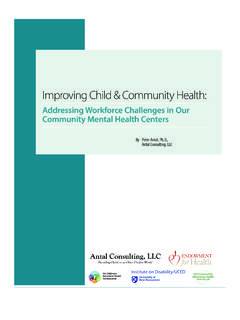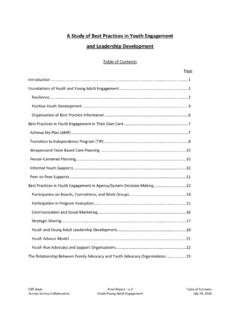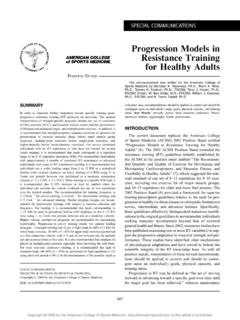Transcription of Tai Ji Quan: Moving for Better Balance Fact Sheet
1 Tai Ji quan : Moving for Better Balance fact Sheet Why is NH promoting the implementation of this specific type of Tai Chi? New Hampshire has pursued grant funding to promote community based initiatives to help impact the leading cause of injury death for New Hampshire older adults, falls. This has been done through the partnerships of the New Hampshire Falls Risk Reduction Task Force (Task Force). In addition to falls being a leading cause of injury death, every 15 seconds an adult age 65 and older is treated in a New Hampshire hospital emergency room for a fall-related injury. Two evidence based programs have been chosen by the Task Force to address this issue in New Hampshire, Matter of Balance and Tai Ji quan : Moving for Better Balance (TJQMBB).
2 Although Tai Chi is beneficial for overall health in older adults, Tai Ji quan : Moving for Better Balance is one of only two evidenced based Tai Chi program that meets the Administration on Aging s Title III-D Highest Tier Evidence-Based Health Promotion/Disease Prevention Programs list. TJQMBB was created at the Oregon Research Institute by Dr. Fuzhong Li. Tai Ji quan : Moving for Better Balance (formally known as Tai Chi: Moving for Better Balance ) is an evidence-based fall prevention program derived from a contemporary routine known as Simplified 24-Form Tai Ji quan (pronounced tye gee chuwan). TJQMBB consists of an 8-form core with built-in practice variations and a subroutine of Tai Ji quan - Mini Therapeutic Movements , which, collectively, comprise a set of functional Tai Ji quan exercises.
3 TJQMBB represents a substantive enhancement of traditional Tai Ji quan training and performance as it transforms martial arts movements into a therapeutic regimen aimed at improving postural stability, awareness and mindful control of body positioning in space, functional walking, movement symmetry and coordination, range of motion around the ankle and hip joints, and lower-extremity muscle strength. Who should participate in this program? The program is designed to improve strength, Balance , mobility and daily functioning, and prevent falls in older adults and individuals with Balance disorders. It is intended to be delivered to community-dwelling older adults and people with a history of falls, Balance disorders, leg muscle weakness, abnormal gait or walking difficulty.
4 The program is able to accommodate people with a mild level of mobility difficulty ( , people who are occasional cane users). What sets this program apart from other forms of Tai Chi offered in many community settings? Health care providers are being asked to screen for fall risk and need resources in the community to refer to when strength and Balance training is indicated. Much of medicine is science based and health care providers will be seeking evidence based interventions to help prevent falls in their patients. This program is an evidence based program recognized by Administration on Aging s Title III-D Highest Tier Evidence-Based Health Promotion/Disease Prevention Programs.
5 As many people with Balance and mobility issues are referred to physical therapists this program has recently incorporated special strategies that will incorporate tai chi into physical therapy treatment. The first training in the United States with this special emphasis just occurred in New Hampshire in September of 2014. The program was embraced by physical and occupational therapists as a way to augment the therapy they use to address Balance and mobility disorders. Mini Therapeutic Movements are a critical difference that set traditional Tai Chi and this program apart. TQJMBB s therapeutic approach incorporates established principals of postural control, the ability of someone to maintain their center of gravity over their base of support during movement thus maintaining Balance .
6 Postural control requires coordination of the individual, task and environment. To improve postural control, one s sensory systems including somatosensory, vestibular and visual systems need challenging as does one s muscular strength and joint flexibility. TQJMBB s Mini Therapeutic Movements and the variations to the 8-form routine accomplish this by incorporating coordinated hand eye movement, challenging one s limits of stability (how far you can sway away from your center of gravity to the limits of your base of support) and incorporating eyes closed exercises. It also incorporates exercises to improve one s ability to quickly react to catch their Balance from a trip or slip.
7 Physical therapists refer to this Balance disturbance from a slip or trip as a perturbation and the recovery of Balance as reactive postural control. Traditional Tai Chi only incorporates anticipatory postural control where there is a planned response to a potential disturbance in Balance . Cognitive deficits and dual task (performing a motor task and alternative task such as talking at the same time) difficulties also contribute to falls. Cognitive challenges are incorporated in TQJMBB in both the Mini Therapeutic Movements and 8 Form variations. This therapeutic approach with non-traditional Tai Chi components of TQJMBB is important for functional improvement in Balance and decreasing fall risk.
8 Dr. Li s research has shown a decrease in fear of falling by 55% in older adults and a decrease risk of multiple falls by 55% in older adults and by 67% in individuals with Parkinson s disease with group based Tai Ji quan : Moving For Better Balance community based classes. His work with the Parkinson s population, published in the New England Journal of Medicine, is a defining aspect of this program and provides an exciting option for people with Parkinson s disease to decrease risk of falls and improve quality of life. For more information about Tai Ji quan : Moving for Better Balance visit For more information about the New Hampshire Falls Risk Reduction Task Force contact: Debra Samaha Program Director, Injury Prevention Center at Dartmouth-Hitchcock Medical Center 1 Medical Center Drive Lebanon, NH 03756 Phone: 603-653-8360 Email: Or Dawna Pidgeon Dartmouth Hitchcock Medical Center 1 Medical Center Drive Lebanon, NH 03756 Phone: 603-650-5978 Email.





